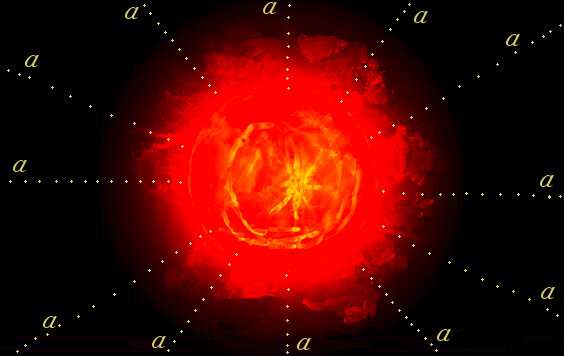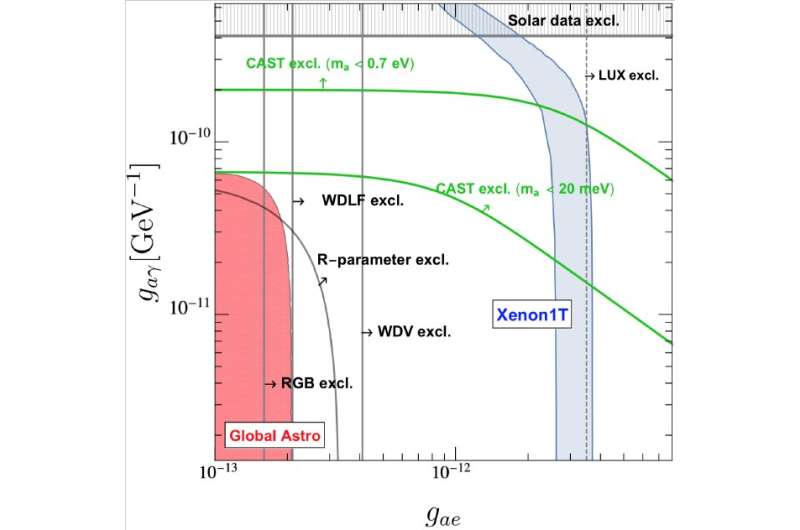Artist representation of a Red Giant star emitting axions. Axion-electron couplings of the size required to account for the XENON1T excess would inevitably turn other stars, like the Red Giant in the picture, into bright `axion lighthouses', drastically changing their luminosity and their evolution. Credit: Di Luzio et al.
For several decades, physicists and astrophysicists have theorized about the existence of dark matter in the universe. This elusive type of matter would be made up of particles that do not absorb, reflect or emit light, and that hence cannot be detected using conventional instruments for observing particles.
One of the most promising dark matter candidates is the axion. Axions are hypothetical particles that were first introduced to explain unusual observations related to strong nuclear interactions. Subsequently, theoretical physicists have suggested that axions make up parts of the universe's mass that are still unaccounted for and could thus essentially be dark matter. Since then, countless teams worldwide have conducted searches for axions using a variety of powerful and sophisticated detectors.
A few months ago, an International research group known as the XENON Collaboration released new data collected by XENON1T, a sensitive detector of interactions between dark matter and common particles. This data contained a surprising excess of events that may be a hint of the existence of particles never before observed, such as solar axions.
Researchers at Deutsches Elektronen-Synchrotron (DESY), University of Barcelona, Barry University and Laboratori Nazionali di Frascati (INFN) recently examined the data gathered by the XENON1T detector with the hope of better understanding whether the excess detected could, in fact, be a manifestation of solar axions. The results of their analyses and their considerations, published in Physical Review Letters, seem to rule out the possibility that solar axions are behind the XENON Collaboration's unexpected observations.
"When the XENON1T result was announced, we were carrying out a thorough study of the effects of axion emission from various astrophysical bodies," via email, Luca Di Luzio, Marco Fedele, Maurizio Giannotti, Federico Mescia and Enrico Nardi, the researchers who carried out the study, told Phys.org, "We thus were in an optimal situation to readily realize that the specific axion properties required by the XENON1T explanation were in strong conflict with observations of stellar evolution."
In their recent paper, Di Luzio and his colleagues show that the hypothesis of solar axions as the XENON1T excess does not hold, as it clashes with previous astrophysical observations. Their hope is that by ruling out this possibility, their work will encourage other teams to identify and explore alternative explanations. According to the researchers, the excess is far more likely to be either the result of an unaddressed issue with the experimental setup or an indication of a different exotic physical phenomenon.
An explanation of the XENON1T anomalous signal requires that the axion couplings to photons and to electrons lie inside the blue region of this plot. However, astrophysical observations imply that the allowed region for the same two couplings cannot extend much outside the red region. The large separation between the two regions allowed the researchers to conclude that the XENON1T data cannot be accounted for by solar axions. Credit: Di Luzio et al.
"Solar axions cannot explain the XENON1T anomalous observation simply because, when compared with other types of stars characterized by much larger core densities and temperatures, the sun is not very efficient at producing axions," the researchers explained. "If the excess observed were to be interpreted as due to solar axions, other type of stars would then overproduce axions, they would shine as intense 'axion lighthouses,' loosing energy from their inner cores at such a large rate that their evolution would be drastically altered. This would be in serious conflict with many past astronomical observations."
One example of astronomical data that clashes with the solar axions hypothesis is the observation of stellar populations. To explain the XENON1T excess, in fact, solar axions would need to have parameters so large that an entire stellar population, the so-called Horizontal Branch (HB) stars, would be very scarcely populated. If that were the case, no HB stars should be found in the nearby globular clusters, where researchers have actually detected several of them.
"Our study should be mainly understood as a contribution to maintain the efforts of the community on the right track," the researchers said. "Initial enthusiasm for a possible 'axion discovery' might have diverted experimental and theoretical efforts in a direction that is, in fact, a dead end."
In addition to excluding the possibility that solar axions explain the XENON1T excess, the recent work conducted by Di Luzio and his colleagues highlights the importance of carefully considering the astrophysical implications of axion models when trying to assess their phenomenological viability. In their paper, the researchers emphasize the importance of the relationship between axions and astrophysics, as the first evidence of the existence of axions could eventually come directly from astrophysical observations.
The team is now conducting further studies exploring axion physics. These studies focus on a wide range of topics, including the cosmological and astrophysical consequences of axions, axion model building and the phenomenological aspects of axion searches carried out in both laboratory and ground based experiments.
"Each member of our collaboration has specific skills in different aspects of axion physics," the researchers said. "As a collaboration, we are presently carrying out a thorough analysis of a large number of astrophysical observables, some of which exhibit intriguing discrepancies between theoretical predictions and observations. Although when taken singly the level of significance of each anomaly is so far moderate, a global analysis might reveal a consistent pattern, and might point towards an explanation in terms of some specific type of axion."
More information: Luca Di Luzio et al. Solar Axions Cannot Explain the XENON1T Excess, Physical Review Letters (2020). DOI: 10.1103/PhysRevLett.125.131804
Journal information: Physical Review Letters
© 2020 Science X Network

























